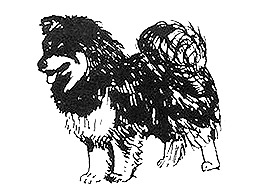Breed standards
Finnish Lapphund
Breed standards are the official guidelines that describe the ideal characteristics, temperament, and appearance of a breed and ensures that the breed is fit for function with soundness essential.

Revised FCI Standard No 189 dated 12 March 1999
Effective in Australia from 1 January 2000
Country of Origin: Finland
Translated by: The Finnish Kennel Club
For hundreds of years the Sami people have used dogs of the same type as Finnish Lapponian Dog as reindeer herders and watchdogs in the northern parts of Fennoscandia and Russia. The first standard of the Lapponian Herder was established by the Finnish Kennel Club in 1945. The breed´s name was changed into Lapponian Dog in 1967. In the 1970:s the type and the characteristics of the breed became stabilized, the standard has been revised several times. The breed name was again changed into Finnish Lapponian Dog in 1993. The breed type has become homogeneous in a short time and today the breed is very popular mainly as a companion and utility dog in the whole of Finland.
Smaller than medium sized. Strongly built for his size, slightly longer than the height at the withers. The coat is long and dense.
Important Proportions: The depth of chest is approximately half of the height at the withers. The muzzle is slightly shorter than the skull. The skull is slightly longer than its width, the depth is the same as the width.
Utilisation: Originally a herder and watch dog used in the work of keeping reindeer. Today also popular as a companion dog.
FCI Classification: Group 5 Spitz and primitive type, Section 3 Nordic Watchdogs and Herders. Without working trial.
Intelligent, courageous, calm and docile. Friendly and faithful.
Strong in outline, rather broad.
Cranial Region:
Skull: Broad, the skull is slightly convex. The forehead is rather domed. The frontal furrow is clearly defined.
Stop: Clearly defined.
Facial Region:
Nose: Black or brown, according to coat colour.
Muzzle: Strong, broad and straight; viewed from above and in profile evenly, but only slightly tapering.
Lips: Tight.
Cheeks: The zygomatic arches are well pronounced.
Oval shaped, dark brown, according to coat colour. The expression is soft and friendly.
Medium sized, carried erect or semi-erect, set rather apart, rather broad at the base, triangular in shape and very mobile, also the inner side is covered with hair. It is equally acceptable that one ear is erect and the other semi-erect.
The jaws are strong. Scissor bite.
Medium in length, strong and covered with profuse hair.
General appearance: Powerful with strong bones. Viewed from the front straight and parallel.
Shoulders: Slightly oblique.
Upper arms: As long as the shoulder blades. The angle between shoulder and upper arm is rather open.
Elbows: Approximately at the level of the lower edge of the ribcage, pointing straight backwards.
Forearms: Rather strong, vertical.
Carpus: Flexible.
Pasterns: Of medium length, slightly oblique.
Withers: Muscular and broad, only slightly pronounced.
Back: Strong and straight.
Loin: Short and muscular.
Croup: Of medium length, well developed, only very slightly sloping.
Chest: Deep, rather long, reaching almost to the elbows, not very broad. The ribs are slightly arched; the fore chest clearly visible, not very strong.
Underline and belly: Only slightly tucked up.
General appearance: Strong boned, powerful, viewed from behind straight and parallel. The angulation is clearly marked with no exaggeration.
Upper thigh: Of medium length, rather broad with well-developed muscles.
Stifle: Parallel, rather well angulated.
Second thigh: Relatively long and sinewy.
Hocks: Moderately low, rather well angulated but not excessively.
Metatarsus: Rather short, strong and vertical.
Forefeet: Well arched, oval rather than round, covered with dense hair. The pads are elastic. Dense hair between the pads.
Hind feet: As front feet.
Set rather high, medium in length, covered with profuse and long hair. The tip of the tail may have a J-formed hook. When
moving the tail is curved over the back or side, in rest it may hang.
Effortless. Changes easily from trot to gallop. The legs move parallel. When working agile and fast.
Skin: Tight, without wrinkles.
Hair: Profuse, especially the males have an abundant mane. The outer coat is long and harsh. On the head and on the front side of the legs the coat is shorter. There has to be an undercoat that is soft and dense.
All colours are permitted. The basic colour must be dominant. Colours other than the basic colour can occur on head, neck, chest, underside of the body, on legs and tail.
Height at the withers:
Ideal height: males 49 cm and females 44 cm with a tolerance of ±3 cm.
The type is more important than the size.
Any departure from the foregoing points should be considered a fault and the seriousness with which the fault should be
regarded should be in exact proportion to its degree and its effect upon the health and welfare of the dog and on its ability to perform its traditional work.
· Lack of sexual dimorphism.
· Light head.
· Insufficient stop.
· Over angulated or too straight rear angulation.
· Tail carriage continuously lower than the topline.
· Lack of under coat.
· Flat coat.
· Curly outer coat.
· Basic colour not dominant.
DISQUALIFYING FAULTS:
· Aggressive or overly shy.
· Any dog clearly showing physical or behavioural abnormalities.
· Overshot or undershot mouth.
· Kinky tail.
· Full drop ears.
· Male animals should have two apparently normal testicles fully descended into the scrotum.
· Only functionally and clinically healthy dogs, with breed typical conformation, should be used for breeding.



